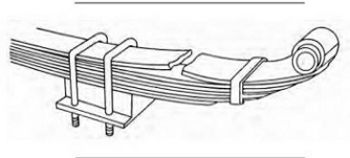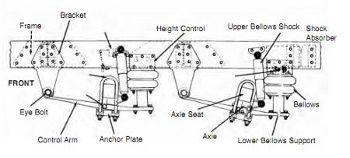Review Questions - Click On The Picture To Begin...

- Cracked or broken spring hangers
- Leaking shock absorbers
- Bent side rails
- Missing or broken leaf springs
Quote From The CDL Manual:
The suspension system holds up the vehicle and its load and keeps the axles in place. Therefore, broken suspension parts can be extremely dangerous. Look for the following:
- Spring hangers that allow movement of axle from proper position.
- Cracked or broken spring hangers.
- Missing or broken leaves in any leaf spring. If 1/4 or more are missing, it will put the vehicle "out of service," but any defect can be dangerous.
- Broken leaves in a multi-leaf spring, or leaves that have shifted so they might hit a tire or other part.
- Leaking shock absorbers.
- Torque rod or arm, U-bolts, spring hangers, or other axle positioning parts that are cracked, damaged or missing.
- Air suspension systems that are damaged and/or leaking.
- Any loose, cracked, broken or missing frame members.
- No more than 1/4 of the leaf springs can be missing
- No more than 1 leaf spring can be missing
- None can be missing
- No more than 1/2 of the leaf springs can be missing
Quote From The CDL Manual:
Suspension systems: The suspension system holds up the vehicle and its load and keeps the axles in place. Therefore, broken suspension parts can be extremely dangerous. Look for the following:
- Spring hangers that allow movement of axle from proper position.
- Cracked or broken spring hangers.
- Missing or broken leaves in any leaf spring. If 1/4 or more are missing, it will put the vehicle "out of service," but any defect can be dangerous.
- Broken leaves in a multi-leaf spring, or leaves that have shifted so they might hit a tire or other part.
- Leaking shock absorbers.
- Torque rod or arm, U-bolts, spring hangers, or other axle positioning parts that are cracked, damaged or missing.
- Air suspension systems that are damaged and/or leaking.
- Any loose, cracked, broken or missing frame members.
TruckingTruth's Advice:
Be sure to memorize that 1/4 or more leaf springs missing is unacceptable and will put the vehicle out of service. This may be included on the written exam and will need to be memorized for the pre-trip exam.
- Fire extinguisher, spare electrical fuses (unless equipped with circuit breakers), and three red reflective warning triangles
- First aid kit, fire extinguisher, and three red reflective warning triangles
- Fire extinguisher, first aid kit, and road flares
- Spare electrical fuses (unless equipped with circuit breakers), road flares, and a fire extinguisher
Quote From The CDL Manual:
Emergency Equipment Vehicles should be equipped with the following emergency equipment:
- Fire extinguisher(s)
- Spare electrical fuses (unless equipped with circuit breakers)
- Warning devices for parked vehicles (e.g., three reflective warning triangles)
TruckingTruth's Advice:
It is almost a guarantee that a question like this will show up on your written exam. You will certainly be asked about emergency equipment during your pre-trip exam as well. The three required pieces of emergency equipment that must be carried with you has to be memorized. This one is very important!
- All of these are required
- First Aid Kit
- Fire Extinguisher
- Three red reflective triangles
Quote From The CDL Manual:
Emergency Equipment: Vehicles should be equipped with the following emergency equipment:
- Fire extinguisher(s)
- Spare electrical fuses (unless equipped with circuit breakers)
- Warning devices for parked vehicles (e.g., three reflective warning triangles)
TruckingTruth's Advice:
It is almost guaranteed that this type of question will show up on both your written exam as well as the pre-trip exam. The 3 required emergency equipment items absolutely must be memorized!










 TT On Facebook
TT On Facebook